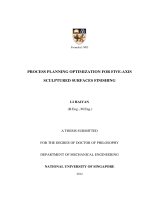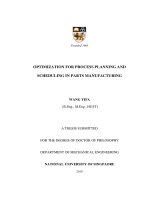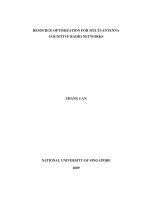Condition optimization for phosphate solubilization by Kosakonia cowanii MK834804, an endophytic bacterium isolated from Aegle marmelos
Bạn đang xem bản rút gọn của tài liệu. Xem và tải ngay bản đầy đủ của tài liệu tại đây (554.73 KB, 13 trang )
Int.J.Curr.Microbiol.App.Sci (2019) 8(8): 2823-2835
International Journal of Current Microbiology and Applied Sciences
ISSN: 2319-7706 Volume 8 Number 08 (2019)
Journal homepage:
Original Research Article
/>
Condition Optimization for Phosphate Solubilization by Kosakonia cowanii
MK834804, an Endophytic Bacterium Isolated from Aegle marmelos
Sangeeta Panigrahi1 and Chandi Charan Rath2*
1
Department of Botany, College of Basic Science and Humanities, Odisha University of
Agriculture and Technology (OUAT), Bhubaneswar, 751003, India
2
Department of Life Sciences, Rama Devi Women’s University, Bhubaneswar, 751022, India
*Corresponding author
ABSTRACT
Keywords
Phosphate solubilization.
Aegle marmelos,
Kosakonia cowanii,
Tricalcium phosphate,
Organic acid
Article Info
Accepted:
22 July 2019
Available Online:
10 August 2019
In the present study endophytic bacteria were isolated from Aegle marmelos and were
screened for phosphate solubilizing activity. The isolate AP01 showed the ability to
solubilize inorganic tricalcium phosphate and thus was characterized. Phenotypic,
biochemical and genotypic analysis revealed, the isolate to be Kosakonia cowanii, a gram
–ve proteobacterium of family enterobacteriaceae with accession no. MK834804, of the
three media viz. Pikovskaya’s agar (PKVA), National Botanical Research Institute’s
phosphate growth medium (NBRIP) and NBRIP-BPB (Bromo Phenol Blue) agar media
tested for Phosphate solubilizing efficiency, the isolate showed high Phosphate
solubilizing Index (PSI 4.5) in PKVA medium. Whereas, under submerged fermentation
the isolate showed highest phosphate solubilization in NBRIP medium (70.200µg/ml) on
4th day with maximum drop down of medium pH (3.6). Optimum solubilization of
phosphorus was observed at temperature 37ºC (70.403µg/ml), pH 8 (71.748 µg/ml) with
0.5 % ammonium sulphate (79.76µg/ml) and 2% Lactose (87.283µg/ml) on 4 th day of
incubation period as optimal nitrogen and carbon sources respectively. Release of various
organic acids i.e. oxalic acid, malic acid, tartaric acid and gluconic acid into the medium
was characterized by High Performance Liquid Chromatography (HPLC), during
phosphate solubilization by the isolate.
Introduction
Chemical fertilizers from the last few decades
have been as a source of nutrients for crop
plants. After nitrogen, the next important
macronutrient required for plant growth is
phosphorus (Bakhshandeh et al., 2015).
Recently, farmers are using large amounts of
phosphatic fertilizer but only 10-25% is
available to the plant rest become
immobilized, leading to frequent input of
these fertilizer making the process too cost
effective as well as affect adversely to the soil
environment (Bhattacharyya and Jha, 2012).
Due to its low solubility by forming
precipitates with some ions like iron,
aluminum, calcium etc. it is unavailable to
plants thereby limiting the plant growth (Liu
et al., 2014). So, for the better growth of the
plant the phosphorus fixed in the soil must be
solubilized and mobilized. There are many
reports on soil microorganisms acting as bio-
2823
Int.J.Curr.Microbiol.App.Sci (2019) 8(8): 2823-2835
phospho inoculants, but the use of endophytic
microorganisms does have the better ability to
solubilize this insoluble form of phosphorus
than the soil or facultative microorganisms
due to long co-evolutionary process within the
host (Rosenblueth and Martínez-Romero,
2006). They make phosphorus (P) available to
plants by secretion of low molecular weight
organic acids thereby lowering the pH, which
release the bound phosphate by blocking the P
adsorption site in the soil particle (Rathi and
Gaur, 2016; Pande et al., 2017). The use of
phospho-endobacteria alone or along with
reduce amount of phosphate fertilizer could
lead to organic and sustainable cultivation by
reducing environmental pollution (Bakshandeh
et al., 2015). With this aim, the present study
is concerned with isolation of endophytic
bacteria from different parts of well-known
medicinal plant i.e. Aegle marmelos
(Rutaceae) and characterization for phosphate
solubilizing capabilities in vitro in different
phosphatic media by analysis of organic acids
to a possible extent for biotechnological
exploitations of untapped microorganisms.
bacteria were isolated following a standard
protocol (Panigrahi et al., 2018). All the
selected isolates were pure cultured and were
maintained at 4˚C till further use.
Preliminary screening of endophytic
bacteria for phosphate solubilization
Phosphate solubilizing activity of the isolates
was qualitatively tested on Pikovskaya’s agar,
National Botanical Research Institute’s
Phosphate (NBRIP) and NBRIP-bromo phenol
blue (NBRIP+0.025gm/l bromo phenol blue)
agar medium by following the methods of
Panigrahi et al., (2018). Each of the medium
containing tricalcium phosphate (Ca3(PO4)2)
as the insoluble phosphate source. Formation
of dissolution zone around the colonies is
indicative of positive phosphatase activity and
the Phosphate Solubilization Index (PSI) was
determined by using the formula of (Premono
et al., 1996; Atekan et al., 2014).
Halo Zone + Colony Diameter
PSI = -----------------------------------------------Colony Diameter
Materials and Methods
Quantitative
analysis
of
phosphate
solubilizing efficiency of the isolate
Media and chemicals used
Nutrient agar, Pikovskaya’s broth and agar
media, National Botanical Research Institute’s
Phosphate Growth Medium (NBRIP), Bromo
Phenol Blue (BPB), KB009B1, KB009C kit
and Hi25 Enterobacteriaceae Identification kit
(KB003) strips were procured from HiMedia
Pvt. Ltd. Mumbai, India and prepared as per
manufacturer’s instructions and used in the
study.
Sample collection
Infection free healthy twigs of Aegle
marmelos (Bael) were collected from the
garden [Odisha University of Agriculture and
Technology, Bhubaneswar (India)], brought to
the laboratory in sterile poly bags. Endophytic
Quantitative
estimation
of
phosphate
solubilization was carried out in 100 ml of
Pikovskaya’s Broth (PKVB) (pH 7) and
NBRIP broth medium (pH 7) in 250 ml
Erlenmeyer flask inoculated in triplicate with
1 ml of active culture of selected endophytic
bacterial isolate AP01 which showed highest
solubilization index in the solid medium. The
flasks were then incubated at 37±2˚C for 11
days. An aliquot of 5ml was taken out from
each flask at 24 h intervals, the pH was
measured and then centrifuged at 6,000 rpm
for 20 minutes and the clear supernatant was
used for determination of available
phosphorus
concentration
spectrophotometrically by the phospho-molybdenum
method (Holman, 1943) at 660 nm.
2824
Int.J.Curr.Microbiol.App.Sci (2019) 8(8): 2823-2835
Uninoculated medium served as control. The
Potassium dihydrogen phosphate was used to
make standard curve for determination of
concentration of soluble phosphorus. The
experiments were conducted in triplicates and
values were expressed as their mean values
and standard error of mean. Highest activity
observed with the medium was considered as
the suitable medium and was taken for further
characterization and optimization of the
isolate. The suitable medium was then
supplemented with Aluminum phosphate
(AlPO4) & Ferric phosphate (FePO4) to check
the efficiency of the isolate to solubilize these
inorganic phosphates.
Condition optimization for phosphatase
activity of the isolate AP01
Both physical (incubation day, pH and
temperature) and nutritional (varied carbon
and nitrogen source) parameters were
optimized for maximum solubilization of
phosphorus in the NBRIP medium by the
isolate in triplicates by following the
procedure of Holman, (1943). Optimum
temperature and pH for maximum phosphate
solubilization was studied by culturing the
selected isolate at different temperature (30,
37, 40, 45, 50º C) and pH (pH 4-12) and the
assay was done at optimal day of incubation.
Effect of various nitrogen sources (sodium
nitrate,
potassium
nitrate,
ammonium
molybdate, peptone, urea, calcium nitrate,
ammonium sulphate, asparagine) at varied
concentration (0.1%, 0.3%, 0.5%, 1% w/v)
and carbon sources (mannitol, dextrose,
maltose, fructose, lactose, sucrose, trehalose,
arabinose) at different concentration (0.5%,
1.0%, 1.5%, 2.0% w/v) on solubilization of
phosphorus by the isolate AP01 was studied
by supplementing to the NBRIP medium and
assay was made by the method of Holman
(1943).
Organic acid analysis
For the analysis of organic acid, the isolate
AP01 was inoculated in 50ml of NBRIP
medium and was incubated at 37º C upto 4th
day. The cells were then harvested and
centrifuged at 6000 rpm for 20 min. The
supernatant was then filtered through 0.2 m
Syringe filter and was subjected for HPLC
analysis. The identification of organic acids
was performed using an Agilent 1260 Infinity
series HPLC system (Agilent Technologies,
Inc., Santa Clara, CA, USA) ZORBAX
300Extend- C18 (250 mm×4.6 mm, 5 µm)
column was used (Agilent Technologies, Inc.).
The filtered supernatant (20 µl) was injected
into the HPLC unit using a glass syringe with
8 mM H2SO4 with a flow rate of 0.6 ml min-1
at 25ºC. Organic acid concentrations in the
sample were determined with the help of RI
detector. The unknown organic acids present
in the supernatant were determined by
comparing with the retention time of peaks of
standard organic acids like tartaric acid, oxalic
acid, malic acid, gluconic acid and citric acid.
Phenotypical
and
characterization of AP01
Biochemical
Phenotypically the isolate AP01 was
characterized on Nutrient Agar (NA),
Pikovskaya’s Agar (PA), MacConkey and
NBRIP agar plates and were analyzed
microscopically by Grams staining and
Scanning Electron Microscopic image. The
strain AP01 was characterized biochemically
by using HiCarbo Kit (KB009B1 / KB009C)
and Hi25 Enterobacteriaceae Identification kit
(KB003) obtained from HiMedia Laboratories
Pvt. Ltd. (India). Enzymatic analysis was done
by plate assay method for different
extracellular enzymes viz. Amylase, Catalase,
Lipase and Protease (Panigrahi et al., 2018).
2825
Int.J.Curr.Microbiol.App.Sci (2019) 8(8): 2823-2835
Identification of Bacterial Isolate Using 16S
rRNA Gene Sequence
The Phospho-endo bacterial isolate AP01 was
identified at species level with 16s rRNA gene
sequence homology method (Genexplore
Diagnostics and Research Centre Pvt Ltd.
Ahmadabad, Gujarat, India). DNA sequencing
reaction of PCR amplicon was carried out
with 8F & 1492R primers using BDT v3.1
Cycle sequencing kit on ABI 3500xl Genetic
Analyzer. The 16S rDNA sequence was used
to carry out BLAST (Zhang et al., 2000) with
the database of NCBI Genbank database
website
().
The
phyllogenetic tree and the evolutionary history
were conferred by using Neighbor Joining
Method (Saitou and Nei, 1987) by using the
Molecular Evolutionary Genetics Analysis
version 7.0 (MEGA 7) software (Kumar et al.,
2016). The analyses of number of base
substitution per site from between sequence
were conducted using Maximum Composite
Likelihood model (Tamura et al., 2004).
Effect of osmotic stress on the growth of the
isolate AP01
To study the osmotic stress of the isolate
AP01, different concentrations of PEG 6000
(0%, 5%, 10%, 15%, 20%, 25%, 30%, 35%,
40%, 45% and 50%) was supplemented with
nutrient broth and were inoculated with 2%
inoculum of the isolate (AP01) and incubated
at 37ºC for 48hr in an orbital shaker.
NaCl tolerance capacity of AP01
Different concentration of NaCl (0.5%, 1%,
1.5%, 3.0%, 5.0%, 7.0%, 8.0%, 9.0%, 10%,
12% and 15%) were taken in Nutrient Broth
(NB) and inoculated with isolate (AP01) and
incubated at 37±2°C for 24hours.
The absorbance of the cultures was measured
using
UV-Visible
spectrophotometer
(Systronics, 118, serial no. 2022) at 600 nm.
The viability of the isolate was tested by subculturing one loop of sample on Nutrient agar
plate from the previously cultured test tubes.
Data analysis
All the experiments were carried out in
triplicates. Error bars show Mean of triplicates
with Standard Error of Mean. Two- way
Analysis of variance (ANOVA) with the SPSS
statistic program version 16.0 was performed
for experiments.
Linear regression study was used to know the
degree of association between pH and soluble
phosphorus and among the variables taken for
optimization of physical parameter studies i.e.
Temperature, pH, Incubation day.
Results and Discussion
Isolation of endophytic bacteria
Detremination of Thermal Death Point and
Thermal Death Time of AP01
Four bacteria were isolated in toto on NA
from different parts of A. marmelos isolated
from petiole (AP01), leaf (AL01) and stem
(AS01, AS02) with colonization frequency of
(6.66%), (6.66%) and (13.33%) (Panigrahi et
al., 2018).
Thermal Death Point (TDP) and Thermal
Death Time (TDT) of the isolate AP01 was
determined by following the methods of Nadia
et al., (2018).
All the endophytic bacterial isolates were pure
cultured on NA plates (3 streak method) and
were preserved at 4°C on NA slants for future
use.
Growth of the isolate was determined
spectrophotometrically at 600 nm.
2826
Int.J.Curr.Microbiol.App.Sci (2019) 8(8): 2823-2835
Qualitative screening of phospho-endo
bacterial isolate and media optimization
Optimization of growth parameters for
maximum phosphate solubilization
Of the four isolates, one isolate (AP01)
showed a halo zone around the colony on
PKVA agar medium indicating phosphate
solubilizing ability of the isolate. While
studying the phosphate solubilizing ability of
the isolate on NBRIP and NBRIP-BPB agar
medium, the highest PSI (4.5) was found on
PKVA followed by NBRIP (3.3) and NBRIPBPB (3.3) medium (Fig. 1).
From the growth parameters studies it was
observed that the isolate solubilized maximum
insoluble tricalcium phosphate in the NBRIP
medium at 37º C as the optimal temperature
[(70.403µg/ml) (Fig. 4A)] and with pH 8.0
(71.748µg/ml) as the optimal pH after which
the solubilization decreased gradually (Fig.
4B). With above physical parameters, the
isolate
showed
maximum
phosphate
solubilization when the medium was
supplemented with 0.5% ammonium sulphate
(79.76µg/ml) and 2% lactose (released P
87.283µg/ml) as optimal nitrogen (Fig. 4C) &
carbon (Fig. 4D) source.
Quantitative
Estimation
of
soluble
phosphorus and the drop in pH of different
broth medium
This experiment was conducted to study the
effect of broth medium on phosphate
solubilizing ability of the isolate AP01. It was
observed that the isolate in NBRIP medium
could better able to solubilize the insoluble
phosphorus Ca3(PO4)2 as compared to PKV
medium. While, the NBRIP medium was
separately supplemented with AlPO4 and
FePO4, as the source of insoluble
phosphorous,
we
observed
maximum
solubilization of phosphorous in presence of
Ca3(PO4)2 by the isolate.
The isolate could also able to solubilize the
inorganic P source complexed in Fe and Al
but in a declined manner (Fig. 2).
Quantification was carried out on every 24h
for a period of 11 days.
The phosphate solubilizing efficiency of the
isolate AP01 increased from 1st day and
maximum phosphate solubilization (70.200
µg/ml) was observed on 4th day with a drop
down of pH(3.6) of the medium (Fig. 3A &
3B).
However, the amount of released phosphorus
and pH of the medium remained constant after
4th day of incubation (Fig. 3C).
Identification of the isolate
The phosphate solubilizing endophytic
bacterial
isolate
was
identified
by
morphological, biochemical and molecular
methods. The phenotypic characterization of
the isolate, Gram’s reaction, electron
microscopic
feature,
biochemical
characteristics, utilization of different sugars,
TDP, TDT, Osmotic stress and NaCl tolerance
capacities are presented in (Table 1). The
isolate observed to be a gram-ve rod without
spores.
The 16S rRNA gene sequence analysis of the
phosphate solubilizing endophytic bacterial
isolate AP01 showed 97% similarity with
Kosakonia cowanii strain no. 888-76 with
99% query coverage which was confirmed
with BLAST analysis data, thus the isolate
AP01 was identified as Kosakonia cowanii
strain and was submitted to GenBank with
NCBI accession no. MK834804. The
phyllogenetic tree for Kosakonia cowanii
MK834804 was constructed by comparing the
related nucleotide sequence based on
maximum identity score from NCBI database
(Fig. 5).
2827
Int.J.Curr.Microbiol.App.Sci (2019) 8(8): 2823-2835
Fig. 1 PSI of AP01 on different media. Values are the mean of triplicates. Mean ± SD
Fig. 2 Quantification of soluble phosphorus of different inorganic P source in NBRIP medium by the isolate
AP01 after 48 hr of incubation. Values are the mean of triplicates. Mean ± SD
2828
Int.J.Curr.Microbiol.App.Sci (2019) 8(8): 2823-2835
Fig.3 Determination of Optimal incubation period and pH for highest phosphate solubilization.
A: Correlation between final pH and incubation day, Y = -0.095x+4.492 R²=0.434; B:
Correlation between soluble phosphorus and incubation day, Y=3.647x+37.55 R² = 0.539; C:
Change in Phosphate solubilization and pH of the medium with incubation day
Fig.4 Effect of different growth parameters on phosphate solubilizing activity of AP01 A:
temperature, B: pH, C: nitrogen source with varied concentration, D: carbon source with varied
concentration. Values are the mean of triplicates. Mean ± SEM
2829
Int.J.Curr.Microbiol.App.Sci (2019) 8(8): 2823-2835
Fig. 5 The evolutionary history of the isolate AP01 was inferred using the Neighbor-Joining method. The
optimal tree with the sum branch length= 1.29616796 is shown (next to the branches). The evolutionary
distances were computed using the Maximum Composite Likelihood method and are in the units of the number
of base substitutions per site. The analysis involved 17 nucleotide sequences. Codon positions included were
1st+2nd+3rd+Noncoding. All positions containing gaps and missing data were eliminated. There were total of
846 positions in the final dataset. Evolutionary analyses were conducted in MEGA 7.
Fig.6 HPLC chromatogram of the different organic acids present in the culture supernatant of
isolate AP01, cultured in NBRIP medium with tricalcium phosphate at 37ºC, 4th day of
incubation. The organic acids detected in the medium were oxalic acid (RT= 4.688), malic acid
(RT= 5.445), tartaric acid (RT= 5.932) and gluconic acid (RT= 6.187)
2830
Int.J.Curr.Microbiol.App.Sci (2019) 8(8): 2823-2835
Table.1 Physiological and Biochemical characteristics of the isolate AP01
Characteristic
Findings
Characteristic
Cellobiose
Morphology
Colony morphology on Medium, oval, Irregular, Arabinose
creamy, moist, opaque,
Nutrient Agar
measures about 2-4mm
MacConkey agar
PKV agar
NBRIP agar
Shape
Size(SEM Image)
Gram's reaction
Spores
Biochemical Analysis
TSI test
Gas from D-glucose
H₂ S
Mannitol
Motility
Indole
Methyl Red
Nitrate Reduction
Simmon's Citrate test
Urease test
Oval, whitish in colour,
lactose fermenting
Thin, small, transparent
Oval, small
Rods
0.6 x 1.1µm
-ve
+
+
+
+
+
+
+
-
Oxidase
VogesProskauer
Sugar utilization
Glucose
Lactose
Sucrose
+
Xylose
Inulin
Sodium gluconate
+
-
Rhamnose
+
Saccharose
Raffinose
Trehalose
Melibiose
+
+
+
+
+
+
+
Findings
+
+
Melezitose
-
Sorbose
Glycerol
Salicin
Dulcitol
Inositol
Sorbitol
Mannitol
Adonitol
Arabitol
Erythritol
Xylitol
α-Methyl-D-Mannoside
α-Methyl-D-Glucoside
ONPG
Esculin
Malonate
Esculine Hydrolysis
Ammonia production
Physical Properties
NaCl tolerance (0-12%)
Thermal Death Point
Thermal Death Time
Osmotic tolerance
Amino acid utilization
test
Ornithine utilization
Lysine utilization
Phenylalanine
Deamination
Extracellular enzyme
production
Amylase
Protease
Lipase
Catalase
+
+
+
+
+
+
+
+
+
+
57ºC
57ºC, 8 min
25% PEG 6000
-
+
+
+ Positive, - Negative, PKV Pikovskaya’s agar media, NBRIP National Botanical Research Institute’s phosphate
growth mediumagar media.
2831
Int.J.Curr.Microbiol.App.Sci (2019) 8(8): 2823-2835
Thus, from all the identification test studied
above, the isolate AP01 was confirmed to be
Kosakonia cowanii, a proteobacterium of
family Enterobacteriaceae.
NaCl, Thermal and Osmotic
tolerance of the bacterial isolate
stress
It was observed that the isolate could tolerate
12% of NaCl (w/v) in the medium and
Thermal Death Time of the isolate was
observed to be 8 min at 57 °C respectively.
From the Osmotic stress studies it was
observed that the isolate AP01 could grow in
presence of 25% of PEG 6000, but could not
survive at 30% PEG 6000 in the medium.
(Table 1).
Identification of organic acids produced by
the isolate AP01
The identification of the organic acids in the
culture medium of the isolate AP01 was
carried through HPLC analysis on 4th day of
incubation. Four different organic acids viz.
oxalic acid (RT= 4.688), malic acid (RT=
5.445), tartaric acid (RT= 5.932) and gluconic
acid (RT= 6.187) were identified in the
culture medium of the isolate AP01, by
comparing the retention time with standard
organic acids like tartaric acid, oxalic acid,
malic acid, gluconic acid and citric acid (Fig.
6).
Endophytic bacteria as plant growth
promoting agents have been reported by many
authors proving its potential as IAA producer,
phosphate solubilizer, iron chellator etc. in
growth enhancement of different plants by
different mechanism (Rashid et al., 2012;
Souza et al., 2015). Literature stresses less
exploitation of endophytes for their phosphate
solubilizing capacity, the present experiment
was conducted to evaluate the efficacy of
endophytic bacteria from medicinal plant as
phosphate solubilizers. The bacterial isolate
AP01 was able to solubilize the insoluble
phosphorus and was observed it as phosphoendo bacterium. While studying the
potentiality of the isolate as phosphate
solubilizer on different agar media like
Pikovskaya, NBRIP, NBRIP-BPB, the isolate
showed better result in Pikovskaya’s agar
media. Similar studies have been conducted
by Hariprasad (2009), where isolates from
tomato plant showed better results in
Pikovskaya’s solid medium, as observed in
our investigation. But in contrast, the isolate
showed higher degree of phosphate
solubilization in NBRIP broth than in
Pikovskaya’s broth medium, during the
quantitative assay in corroboration to Mehta
et al., (2000). Tricalcium phosphate
(Ca3(PO4)2) was found to be the best
inorganic P source followed by FePO4 and
AlPO4 by the isolate AP01 to make avail of
maximum soluble Phosphorus in the NBRIP
medium and the same was also reported by
Pradhan et al., (2017).
Decrease in pH from neutral to pH 3.6 of the
medium could be due to release of various
organic acids during phosphate solubilization
as reported earlier (Behera et al., 2017 and
Pande et al., 2017). Statistically our result
showed direct relationship between lowering
of the pH and higher solubilization of
phosphorus in the medium. From HPLC
analysis four different organic acid viz. malic
acid, tartaric acid, oxalic acid and gluconic
acid were identified in the culture medium of
the isolate AP01 which could be responsible
for drop down of pH and solubilization of
phosphate in the study. Vyas and Gulati,
(2009) too reported secretion of malic acid,
oxalic acid, gluconic acid, citric acid, succinic
acid, formic acid in the culture filtrate of
fluorescent Pseudomonas strains which
corroborates with our observations. We
recorded production of gluconic acid as the
signature molecule produced by the phosphate
solubilizing microbes of Enterobacteriaceae
2832
Int.J.Curr.Microbiol.App.Sci (2019) 8(8): 2823-2835
family (Buch et al., 2008; Chakdhar et al.,
2018). The isolate AP01 showed better
phosphate solubilizing capabilities in NBRIP
broth, at 37°C. In agreement with our study,
Prasad (2014) reported that the suitable
temperature for the growth condition and
solubilization of phosphate by their isolate to
be 37°C. The isolate showed highest
solubilization of phosphate (70.200µg/ml) on
4th day of incubation after which the
phosphate solubilization decreased. This
could be attributable to the availability of
soluble phosphorus in the medium which acts
as an inhibitory effect on further
solubilization (Chaiharn et al., 2009) and also
it could be due to depletion of nutrient in the
medium (Kang et al., 2002). On the other
hand while studying the effect of C & N
concentration on the phosphate solubilization
it was observed that the isolate showed
highest phosphate solubilizing activity in
presence of 2% lactose (carbon source) and
0.5% ammonium sulphate (nitrogen source).
In agreement to our investigation Rahman et
al., (2017) stated that ammonium sulphate is
the best nitrogen source for bacterial strains
when tricalcium phosphate is given as
insoluble phosphorus source, but according to
the same report fructose has highest effect on
phosphobacteria Pseudomonas & Bacillus sp.
for phosphate solubilization.
phosphate solubilizing bacteria isolated from
Marama seedling to be Kosakonia sps.
It is reported that, in terms of phosphate
solubilizing efficiency, gram –ve bacteria are
most promising rather than gram +ve
bacterium Tripura et al., (2007) which is in
complete accordance with our study. On 16S
rRNA sequencing studies the isolate was
identified to be Kosakonia cowanii belonging
to family Enterobacteriaceae. The bacterial
isolates belonging to genera Kosakonia,
Pantoea and Bacillus are the most promising
phosphate solubilizer (Chakdhar et al., 2018).
In agreement with our conclusion,
Chimwamurombe et al., (2016) conducted an
experiment in which, the endophytic
Conflict of interest
In conclusion, it can be told that the present
study is of its kind on isolation of endophytic
bacteria Kosakonia cowanii MK834804 from
the medicinal plant Aegle marmelos with
phosphate solubilizing ability. It is suggestive
of that; the isolate could be used in agriculture
as a novel source of phosphatic bio-fertilizer
for enhancement of plant growth by making
the insoluble P available to the plants with
further investigations. Though it is a
preliminary endeavor, studies such as this are
a pre-requisite to exploit the biotechnological
potential of endophytes (resident microbes
inside the plants) for their use in agriculture.
Acknowledgement
The authors are thankful to Science and
Technology Department, Govt. of Odisha for
financial support. The authors deeply
acknowledge the Director, College of Basic
Science and Humanities, OUAT, for allowing
to conduct the study. The authors are also
thankful to HOD, Department of Botany,
College of Basic Science and Humanities,
OUAT, for providing laboratory facility.
Compliance with ethical standards
The authors declare no conflict of interest.
References
Atekan, A., Nuraini, Y., Handayanto, E. and
Syekhfani, S. 2014. The potential of
phosphate solubilizing bacteria isolated
from sugarcane wastes for solubilizing
phosphate. Journal of Degraded and
Mining Lands Management. 1(4): 175182.
Bakhshandeh, E., Rahimian, H., Pirdashti, H.
2833
Int.J.Curr.Microbiol.App.Sci (2019) 8(8): 2823-2835
and Nematzadeh, G.A. 2015. Evaluation
of phosphate‐ solubilizing bacteria on
the growth and grain yield of rice
(Oryza sativa L.) cropped in northern
Iran. J.
of
appl.
microbiology.
119(5):1371-1382.
Behera, B.C., Yadav, H., Singh, S.K., Mishra,
R.R., Sethi, B.K., Dutta, S.K. and
Thatoi,
H.N.
2017.
Phosphate
solubilization and acid phosphatase
activity of Serratia sp. isolated from
mangrove soil of Mahanadi river delta,
Odisha, India. J. of Genetic Engineering
and Biotechnol. 15(1): 169-178.
Bhattacharya, P.N. and Jha, D.K. 2012. Plant
growth-promoting
rhizobacteria
(PGPR): emergence in agriculture.
World J. Microbiol. Biotechnol.
28(4):1327-50.
Buch, A., Archana, G., Kumar, G.N. 2008.
Metabolic channelling of glucose
towards gluconate in phosphate
solubilizing Pseudomonas
aeruginosa P4
under
phosphorus
deficiency. Res. Microb. 159:635-642.
Chaiharn, M. and Lumyong, S. 2009.
Phosphate solubilization potential and
stress tolerance of rhizobacteria from
rice soil in Northern Thailand. World
Journal
of
Microbiology
and
biotechnology. 25(2): 305-314.
Chaiharn, M., Chunhaleuchanon, S., Kozo, A.
and Lumyong, S. 2008. Screening of
rhizobacteria for their plant growth
promoting activities. Curr. appl. sci. and
technol. 8(1):18-23.
Chakdar, H., Dastager, S.G., Khire, J. M.,
Rane, D. and Dharne, M.S. 2018.
Characterization of mineral phosphate
solubilizing and plant growth promoting
bacteria from termite soil of arid
region. 3 Biotech. 8(11):463.
Chimwamurombe, P.M., Gronemeyer, J. L.,
Hurek, B.R. 2016. Isolation and
characterization of seed-associated
bacterial
endophytes
from
gnotobiotically grown Marama bean
seedlings.
FEMS
Microbiology
Ecology. 92(6).
Hariprasad, P. and Niranjana, S.R. 2009.
Isolation and characterization of
phosphate solubilizing rhizobacteria to
improve plant health of tomato. Plant
and soil. 316(1-2):13-24.
Holman, W.I.M. 1943. A new technique for
the determination of phosphorus by the
molybdenum blue method. Rowett
Institute. 37:256-259.
Kang, S. C., Ha, G. C., Lee T. G.,
Maheshwari, D. K. 2002. Solubilization
of insoluble inorganic phosphates by a
soil inhabiting fungus sp. Ps 102. Curr.
Sci. 79:439–442.
Kumar, A., Singh, R., Yadav, A., Giri, D.D.,
Singh, P.K., Pandey, K.D. 2016.
Isolation and characterization of
bacterial endophytes of Curcuma longa
L. 3 Biotech, 6:60.
Liu, F. P., Liu, H. Q., Zhou, H. L., Dong, Z.
G., Bai, X. H., Bai, P. and Qiao, J.J.
2014. Isolation and characterization of
phosphate-solubilizing bacteria from
betel nut (Areca catechu) and their
effects on plant growth and phosphorus
mobilization in tropical soils. Biol and
fert of soils. 50(6):927-937.
Mehta, P., Chauhan, A., Mahajan, R.,
Mahajan, P.K. and Shirkot, C.K. 2000.
Strains of Bacillus circulans isolated
from apple rhizosphere showing plant
growth promoting potential. Curr. Sci.
98:538–542.
Nadia, H., El-Batanony., Maha, H., Ali,
Hassan., Hassan, T. 2018. Diversity of
non-rhizobial endophytic bacteria from
nodules of Melilotus indicus L. and
their plant growth promoting activities.
Egypt. J. Exp. Biol. (Bot.). 14(2):253–
266.
Pande, A., Pandey, P., Mehra, S., Singh, M.
and Kaushik, S. 2017. Phenotypic and
genotypic characterization of phosphate
2834
Int.J.Curr.Microbiol.App.Sci (2019) 8(8): 2823-2835
solubilizing bacteria and their efficiency
on the growth of maize. Journal of
Genetic
Engineering
and
Biotechnology. 15(2): 379-391.
Panigrahi, S., Dash, D., Rath, C.C. 2018.
Characterization of endophytic bacteria
with plant growth promoting activities
isolated from six medicinal plants. J.
Exp. Biol. Agric. Sci. 6(5):782–791.
Pradhan, M., Sahoo, R.K., Pradhan, C.,
Tuteja, N. and Mohanty, S. 2017.
Contribution of native phosphoroussolubilizing bacteria of acid soils on
phosphorous acquisition in peanut
(Arachis
hypogaea
L.). Protoplasma. 254(6):2225-2236.
Prasad, M.P. 2014. Optimization of
fermentation conditions of phosphate
solubilization bacteria–a potential biofertilizer. Merit Res J Microbiol Biol
Sci. 2(2):31-35.
Premono, M.E., Moawad, A.M. and Vlek,
P.L.G.1996. Effect
of
phosphatesolubilizing Pseudomonas putida on the
growth of maize and its survival in the
rhizosphere
(No.
REP-12113.
CIMMYT.).
Rahman, C.H., Miloud, B., Rachid,
DAhcene., BHamoum, Hakim. 2017.
Optimisation of inorganic phosphate
solubilisation
by
Pseudomonas
fluroescens & Bacillus sp. isolated from
wheat rhizospheric soil. Intr. J. of
Biosci. 10(4):142-150.
Rashid, S., Charles, T.C., Glick, B.R. 2012.
Isolation and characterization of new
plant
growth-promoting
bacterial
endophytes. Appl. Soil. Ecol. 61:217224.
How to cite this article:
Rathi, M. and Gaur, N. 2016. Phosphate
solubilizing bacteria as biofertilizer and
its
applications. J.Pharm.
Res.
10(3):146-148.
Rosenblueth, M. and Martínez-Romero, E.
2006. Bacterial endophytes and their
interactions with hosts. Molecular plantmicrobe interactions. 19(8):827-837.
Saitou, N. and Nei, M. 1987. The neighborjoining method: a new method for
reconstructing phyllogenetic trees.
Mol.Biol. Evol. 4:406-425.
Souza, R.D., Ambrosini, A. and Passaglia,
L.M. 2015. Plant growth-promoting
bacteria as inoculants in agricultural
soils. Genetics
and
molecular
biology. 38(4):401-419.
Tamura, K., Nei, M. and Kumar, S. 2004.
Prospects for inferring very large
phylogenies by using the neighborjoining method. Proceedings of the
National
Academy
of
Sciences. 101(30):11030-11035.
Tripura, C., Sashidhar, B. and Podile, A.R.
2007. Ethyl
methanesulfonate
mutagenesis-enhanced
mineral
phosphate solubilization by groundnutassociated Serratia marcescens GPS-5.
Curr. Microbiol. 54:79-84.
Vyas, P. and Gulati, A. 2009. Organic acid
production in vitro and plant growth
promotion in maize under controlled
environment by phosphate-solubilizing
fluorescent
Pseudomonas. BMC
microbiol. 9(1):174.
Zhang, Z., Schwartz, S., Wagner, L., Miller,
W. 2000. "A greedy algorithm for
aligning DNA sequences". J. Comput.
Biol. 7(1-2):203-14.
Sangeeta Panigrahi and Chandi Charan Rath. 2019. Condition Optimization for Phosphate
Solubilization by Kosakonia cowanii MK834804, an Endophytic Bacterium Isolated from
Aegle marmelos. Int.J.Curr.Microbiol.App.Sci. 8(08): 2823-2835.
doi: />
2835









